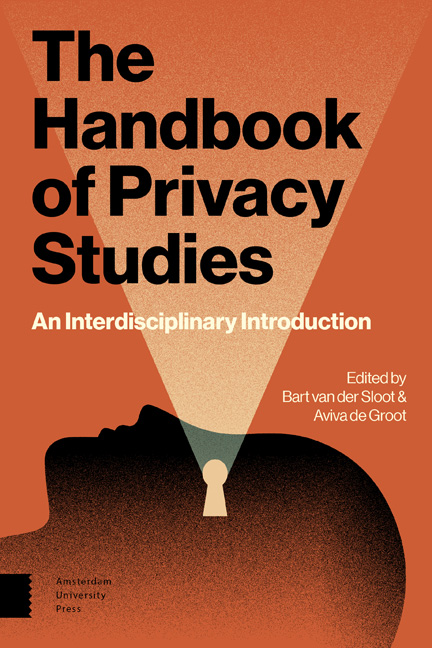Book contents
- Frontmatter
- Contents
- Introduction
- 1 Privacy from a Historical Perspective
- Legislating Privacy: Technology, Social Values, and Public Policy
- 2 Privacy from a Legal Perspective
- Three Dimensions of Privacy
- 3 Privacy from an Ethical Perspective
- Nudging: A Very Short Guide
- 4 Privacy from an Economic Perspective
- Security, Privacy, and the Internet of Things (IoT)
- 5 Privacy from an Informatics Perspective
- Political Science and Privacy
- 6 Privacy from an Intelligence Perspective
- A Privacy Doctrine for the Cyber Age
- 7 Privacy from an Archival Perspective
- Medical Privacy: Where Deontology and Consequentialism Meet
- 8 Privacy from a Medical Perspective
- Privacy Law – on the Books and on the Ground
- 9 Privacy from a Media Studies Perspective
- Diversity and Accountability in Data-Rich Markets
- 10 Privacy from a Communication Science Perspective
- Still Uneasy: a Life with Privacy
- 11 Privacy from an Anthropological Perspective
- About the Authors
5 - Privacy from an Informatics Perspective
- Frontmatter
- Contents
- Introduction
- 1 Privacy from a Historical Perspective
- Legislating Privacy: Technology, Social Values, and Public Policy
- 2 Privacy from a Legal Perspective
- Three Dimensions of Privacy
- 3 Privacy from an Ethical Perspective
- Nudging: A Very Short Guide
- 4 Privacy from an Economic Perspective
- Security, Privacy, and the Internet of Things (IoT)
- 5 Privacy from an Informatics Perspective
- Political Science and Privacy
- 6 Privacy from an Intelligence Perspective
- A Privacy Doctrine for the Cyber Age
- 7 Privacy from an Archival Perspective
- Medical Privacy: Where Deontology and Consequentialism Meet
- 8 Privacy from a Medical Perspective
- Privacy Law – on the Books and on the Ground
- 9 Privacy from a Media Studies Perspective
- Diversity and Accountability in Data-Rich Markets
- 10 Privacy from a Communication Science Perspective
- Still Uneasy: a Life with Privacy
- 11 Privacy from an Anthropological Perspective
- About the Authors
Summary
Introduction
Both ‘privacy’ and ‘informatics’ are semantically overloaded concepts; no broad consensus exists on a single definition of either. This chapter has the following objectives:
– to provide an intuition of ‘privacy’ and of ‘informatics’;
– to provide an understanding of relations between privacy and informatics;
– to provide references to academic and other authoritative sources for further research.
Elaboration is provided on selected topics in this theme. For topics that are already described and discussed in existing sources, references are provided.
An intuition of privacy
At the risk of minor overlap with other chapters, a short characterization of privacy follows to keep this chapter self-contained. It is adapted from earlier work.
Privacy entails some desire to hide one's characteristics, choices, behaviour, and communication from scrutiny by others. A corollary is that privacy entails some desire to exercise control over the use of personal information, for example to prevent future misuse. Phrases commonly associated with privacy include ‘the right to be let alone’, meaning freedom of interference by others; ‘the selective control of access to the self or to one's group’, meaning the ability to seek or avoid interaction in accordance with the privacy level desired at a particular time; and ‘informational self-determination’, meaning the ability to exercise control over disclosure of information about oneself.
Contrary to what some believe, the rise of social media and ubiquitous computing does not imply the ‘end’ or ‘death’ of privacy. Rather, as Evgeny Morozov paraphrased from Helen Nissenbaum's book on contextual integrity in The Times Literary Supplement of 12 March 2010: ‘the information revolution has been so disruptive and happened so fast (…) that the minuscule and mostly imperceptible changes that digital technology has brought to our lives may not have properly registered on the social radar’. In her two and a half-year ethnographic study of American teens’ engagement with social network sites, danah boyd observed that teens ‘developed potent strategies for managing the complexities of and social awkwardness incurred by these sites’. So, rather than privacy being irrelevant to them, the teens found a way to work around the lack of built-in privacy. In conclusion: privacy is not dead.
- Type
- Chapter
- Information
- The Handbook of Privacy StudiesAn Interdisciplinary Introduction, pp. 213 - 256Publisher: Amsterdam University PressPrint publication year: 2018



